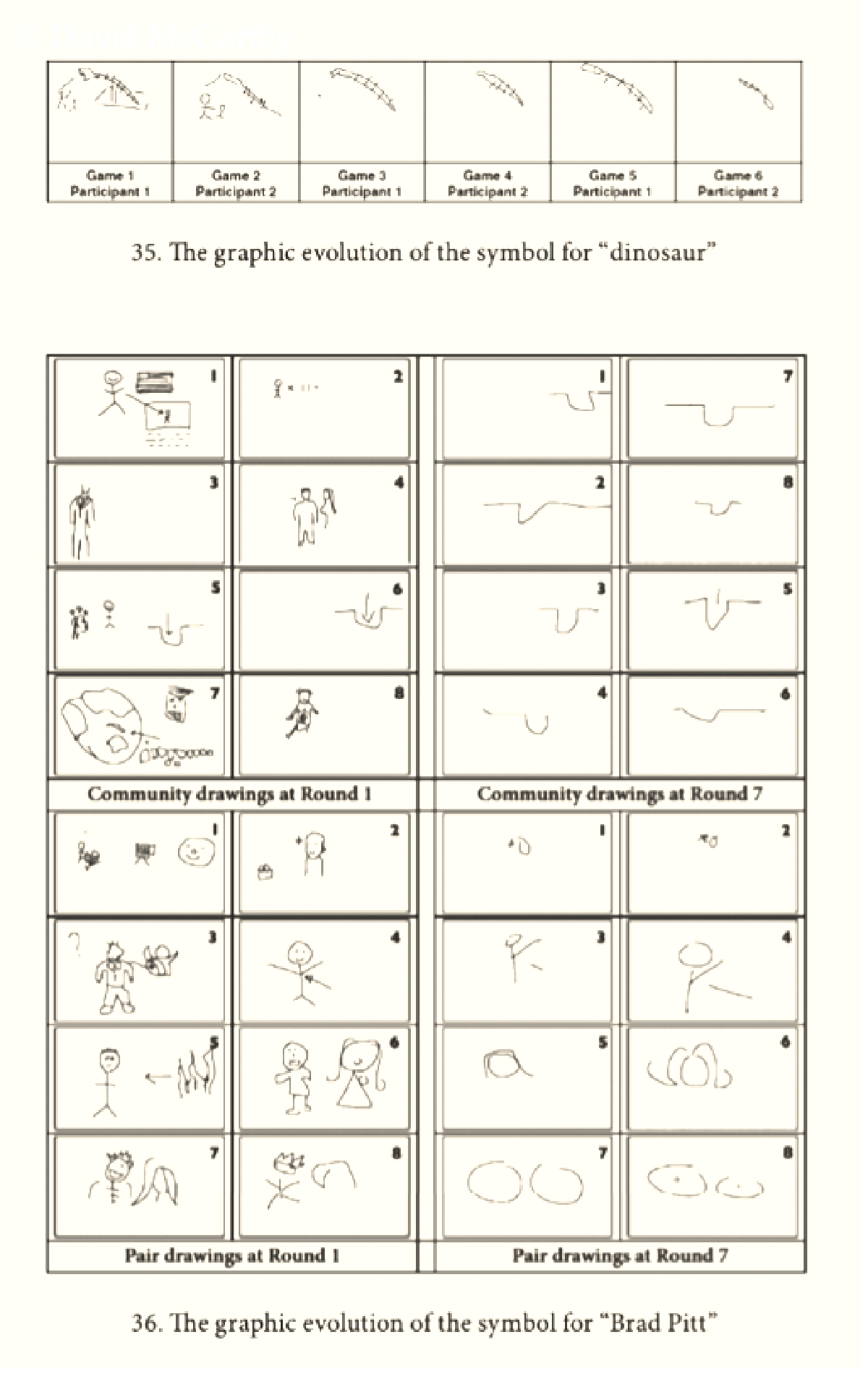“Brad Pitt” from THE GREATEST INVENTION: A History of the World in Nine Mysterious Scripts
Translated from Italian by Todd Portnowitz
Where do symbols come from? Emblems, logos, graphic codes? The experiment we’ll look at here, conducted recently by cognitive psychologists, attempts to provide an answer.
The participants take seats around a table. Without speaking to one another, and therefore without using language (otherwise it’d be too easy), they must pass on a series of messages. All they have at their disposal is pen and paper. They must communicate, in writing, a complex or abstract concept, one that’s difficult to “draw,” like “soap opera,” or “museum,” or “parliament,” or “Brad Pitt.” The game works a bit like Pictionary. The “directors” of the experiment oversee the behavior of the “actors,” monitoring the communication system that develops through repeated interactions.
Three things become immediately apparent: 1. The more the message is repeated, the more successfully it’s communicated (repetita iuvant); 2. The symbols, at first, take on graphic and highly iconic forms, and over time grow less iconic, less detailed, ever more abstract; 3. After multiple interactions, the same signs come to be used to express the same meanings; therefore the participants’ behavior aligns, it converges, growing ever more harmonious.
These three factors drive us toward the birth of graphic symbols, which consists of a fixed set of shared signs. And we can trace this dynamic evolution. Over the course of the two-person experiments (dyads), for example, the drawing for the concept “museum” begins with a plethora of details: the figure of a dinosaur on a platform, with visitors staring up at it. By the sixth exchange, the symbol has evolved, and all that’s left of our poor T. rex is its spine (fig. 35).
This tells us that the more social interaction there is, the more times the participants repeat this exchange, the closer they align around the message’s form, to the point of shedding nearly every indispensable detail. If we interfere a bit with the simulation, namely by adding a group of passive observers, and we then ask them to identify the symbols developed by the active participants, we find that the passive group is a little lost. They can’t keep up with the development; they can’t take part in the sharing of the message.

The graphic symbol for “Brad Pitt” suffers an even worse fate than our dinosaur (fig. 36). The Brad experiment is not merely dyadic, or an interaction between two people, but is conducted with several people in a communication network. The group, divided into four laboratories of eight people each, simulates a mini-society: the participants exchange messages in pairs, until everyone in the group has interacted with one another, building a communication web. And what happens to Brad Pitt is even more surprising than what happens to T. rex.
Things start off just fine for Brad: many depict him with a woman, perhaps because of his quintessential good looks, perhaps to reference Angelina (the article was published before their divorce). What’s surprising is that others use a rebus to identify him. Next to their portrait, they add another drawing of a pit with an arrow pointing into it, or else of an armpit, again with an arrow.
And gradually, exchange after exchange, the symbol begins to morph from its iconic and detailed origins to something more schematic and minimalist, until at last it’s stripped down to the bone, just the sketch of a pit or an armpit. Poor Brad, only the “pit” of him remains.
So what do we learn from all this? We learn that even A-list actors, as “iconic” as they are at first, can be reduced to but faint images of themselves in the dynamic process of social interaction. That little by little symbols go about simplifying themselves, once the message has been received and absorbed. That ultimately it’s the interaction between human beings that determines a symbol’s evolution, via the instructions we pass back and forth to one another in the chain of graphic communication. And that when we take away interaction, leaving symbols to evolve on their own in a long soliloquy, the code becomes a closed system and, rather than shed details, acquires more and more.
And finally — surprise, surprise — we learn that in establishing a convention, a shared code, we again turn to the all-powerful, universal, and instinctual rebus. This should perhaps help us to understand even more how vague a concept the “pictogram” is: language, the sound we make with our tongues, even if we shove it out the door, will always climb back in through the window. We must always give a name and a sound to things. Even when we think we’re just scribbling.